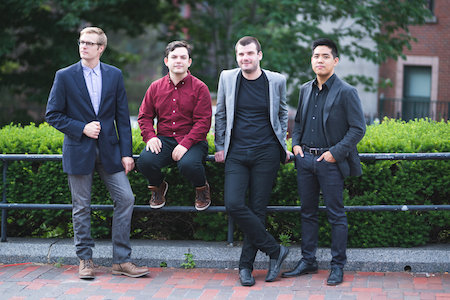by David Kulma

The Boston-based quartet — flutist Michael Avitabile, clarinetist David Dziardziel, violinist Zenas Hsu, and cellist Jesse Christeson — began with a brand-new work by Cleveland composer Andrew Rindfleisch, who curates this concert series. His 10-minute Fun House opens with a wild ruckus followed by snappy woodwind lines reminiscent of Stravinsky’s A Soldier’s Tale over grinding, repeated notes in the strings. Rindfleisch crafted a fun, high-energy piece that was enjoyably ludicrous for irregular shifts into soft, otherworldly wanderings. Especially notable were two solos: Christeson’s off-kilter cello, sounding like a Chaplinesque hobo, and Dzardziel’s slightly menacing, then more bouncing bass clarinet. A glorious major chord ends this mirror-bent carnival well worth repeated visits.
Laura Kaminsky’s The Full Range of Blue from 2001, one of the rarities for this instrumentation written before Hub’s existence, explores a small set of motives — often exploiting a half step — to mimic the blue hues she saw in the Canadian Rockies. While Hub only played seven of its eight movements, that “partial” range of blue was compelling in its metaphorical exactness. The opening “Dawn: Mist Rising” featured glassy drones while Christeson’s cello lamented and Avitabile’s flute worried over the main motive. In “Glacier,” Hsu played an overheated, string-crossing cadenza over immovable, biting chords. “Avalanche” exploits disjointed, staggered pairings that wind up like grinding machinery. The final movement, “Aftermath: Ash (September 12th),” sets the rest in sharp relief, giving the whole work a deeper meaning with its morose acknowledgement of terror.
A Hub commission from 2017 filled the second half. Robert Honstein’s 9-movement, 35-minute Soul House is a nostalgic tour through his childhood home — movement titles include “Stairs,” “Hallway,” and “Driveway.” The driving force for the work appears to be canon technique. The sheer variety of pictures Honstein spun through this well-worn device was startling. The canon in the opening “Bay Window” sounded like long-held notes over spindly shards of light, while “Alcove” — a three-part, high-instrument canon with cello pizzicato — was more covered, and emotionally close to the chest. Spectacular canons spin incessantly throughout “Backyard.” The section when all four players take to the buoyant, jovial melody — each an eighth note apart — was gobsmacking and perfectly played.
The concluding “Secret Place” showed the sense of care — and even love — that Hub New Music brings to their playing. This level of deep musicianship requires enough time and rehearsal for the meaning of the music to seep into the musicians’ pores. It was clear that the quartet felt deeply for this beautiful celebration, and a joy to hear them bring it to life.
Published on ClevelandClassical.com April 4, 2018.
Click here for a printable copy of this article



